MUSIC UNDER THE COMMUNISTS IN CHINA
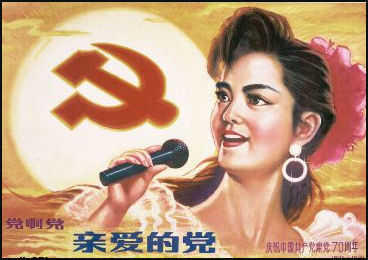 After the establishment of the People's Republic, revolutionary songs continued to be performed, and much of the remainder of popular music consisted of popular songs from the Soviet Union with the lyrics translated into Chinese. Symphony orchestras flourished throughout the country, performing Western classical music and compositions by Chinese composers. Conservatories and other institutions of musical instruction were developed and expanded in the major cities. A number of orchestras from Eastern Europe performed in China, and Chinese musicians and musical groups participated in a wide variety of international festivals. [Source: Library of Congress]
After the establishment of the People's Republic, revolutionary songs continued to be performed, and much of the remainder of popular music consisted of popular songs from the Soviet Union with the lyrics translated into Chinese. Symphony orchestras flourished throughout the country, performing Western classical music and compositions by Chinese composers. Conservatories and other institutions of musical instruction were developed and expanded in the major cities. A number of orchestras from Eastern Europe performed in China, and Chinese musicians and musical groups participated in a wide variety of international festivals. [Source: Library of Congress]
During the height of the Cultural Revolution, musical composition and performance were greatly restricted. After the Cultural Revolution, musical institutions were reinstated and musical composition and performance revived. In 1980 the Chinese Musicians' Association was formally elected to the International Musicological Society. Chinese musical groups toured foreign countries, and foreign musical organizations performed in China. In the mid-1980s popular ballads and Western folk and classical music still drew the greatest audiences, but other kinds of music, including previously banned Western jazz and rock and roll, were being performed and were receiving increasing acceptance, especially among young people.
“Many forms of music---including traditional Chinese music, Peking Opera, classical Western music and pop---were banned during the Mao era, when revolutionary music ruled and traditional music endured underground in regional enclaves and in funeral, teahouse and wedding music. Jiang Qing, Mao’s wife, dictated cultural policy during the Cultural Revolution. She defined musical taste in arbitrary fashion at one time endorsing Aaron Copeland’s film score for “The Red Pony” but at another outlawing the tuba.
Since Mao's death and the end of the Cultural Revolution, these forms have come back along with bawdy, firecracker-accompanied Taoist temple music and various regional operas. And, they have been joined by Cantopop, Mandopop, punk rock, Chinese-language hip hop, and sexually-explicit disco music. Some music and dance were encouraged and subsidized. Many musicians and dancers were professional. Each state had its own state ensembles but their music and shows was tightly controlled and censored and set up to promote the party line.
Ethnic music, folk music,"national" music and culture were officially encouraged but within tightly controlled limits. The aim was not to depict ethnic identity but rather to promote multiculturalism within the Communist system. The censors remain active in music as the do in other forms of art, culture and media. In the Name of Love, a sing by the op singer Faye Wong, was banned because the lyrics contained the word “opium” in them.
See Separate Article MUSIC, OPERA, THEATER AND DANCE factsanddetails.com ; ANCIENT MUSIC IN CHINA factsanddetails.com ; TRADITIONAL CHINESE MUSIC AND MUSICAL INSTRUMENTS factsanddetails.com ; ETHNIC MINORITY MUSIC FROM CHINA factsanddetails.com ; CHINESE DANCE factsanddetails.com ; CHINESE OPERA AND THEATER, REGIONAL OPERAS AND SHADOW PUPPET THEATER IN CHINA factsanddetails.com ; EARLY HISTORY OF THEATER IN CHINA factsanddetails.com ; PEKING OPERA factsanddetails.com ; DECLINE OF CHINESE AND PEKING OPERA AND EFFORTS TO KEEP IT ALIVE factsanddetails.com ; REVOLUTIONARY OPERA AND MAOIST AND COMMINIST THEATER IN CHINA factsanddetails.com
Good Websites and Sources: PaulNoll.com paulnoll.com ; Library of Congress loc.gov/cgi-bin ; Modern Chinese Literature and Culture (MCLC) List of Sources /mclc.osu.edu ; Samples of Chinese Music ingeb.org ; Music from Chinamusicfromchina.org ; Internet China Music Archives /music.ibiblio.org ; Chinese-English Music Translations cechinatrans.demon.co.uk ; Chinese, Japanese, and Korean CDs and DVDs at Yes Asia yesasia.com and Zoom Movie zoommovie.com ; World Music: Stern's Music sternsmusic ; Guide to World Music worldmusic.net ; World Music Central worldmusiccentral.org
RECOMMENDED BOOKS AND MUSIC: “Music as Mao's Weapon: Remembering the Cultural Revolution” by Lei X. Ouyang Amazon.com; “Listening to China’s Cultural Revolution: Music, Politics, and Cultural Continuities” by Laikwan Pang , Paul Clark, et al. Amazon.com “Cultural Revolution and Revolutionary Culture” by Alessandro Russo Amazon.com; “Red Detachment of Woman: a Modern Revolutionary Dance Drama” Amazon.com “Taking Tiger Mountain by strategy;: A modern revolutionary Peking opera” Amazon.com ; “Peng Liyuan: Collection” by Peng Liyuan (Xi Jinping's wife) (CD) Amazon.com; “Legends of China — Peng Liyuan (CD) Amazon.com “Motherland” by Peng Liyuan (CD) Amazon.com; “White Hair's Mother” by Peng Liyuan (CD) Amazon.com “Music in China: Experiencing Music, Expressing Culture (Includes CD) by Frederick Lau Amazon.com; The Very Best Of Chinese Music by Han Ying, Various Artists, et al Amazon.com; “The Music of China's Ethnic Minorities” by Li Yongxiang Amazon.com; “Music, Cosmology, and the Politics of Harmony in Early China” by Erica Fox Brindley Amazon.com; “Chinese Music and Musical Instruments” by Qiang Xi (Author), Jiandang Niu Amazon.com; “Rocking China: Music Scenes in Beijing and Beyond” by Andrew David Field Amazon.com;
Revolutionary Music in China

Most of the music that received air play from the 1940s to the 1980s, was revolutionary music, characterized by march-like music and pro-Communist lyrics. The most well known song was “The East is Red”, whose chorus went: "The east is red! The sun is rising! China has produced Mao Zedong!").
At public gatherings the Red Orchestra usually played the same songs: “The East Is Red”, “Long Live the Thoughts of Mao”, “I Love Beijing's Tiananmen Square”, “The Liu River Song”, “The White-Haired Girl”, and “Sailing the Sea Depends on the Helmsman”.
Among some other classic Communist songs are “A New Look has Come to Our Mountain Village, Without the Communist Party There Would Be No New China, To Rebel Is Justified, The Gurgling Stream Sings of Bumper Harvests, Spring Comes Early in the Commune” and “A Long, Long Life to Chairman Mao”. And we can't forget “Without the Communist Party, There Would Be No China” (sample lyrics: "It pointed the people to the road to liberation/ It leads China toward brightness") and “Follow the Party” ("You are the lighthouse/Shining on the ocean before dawn/ You are the helmsman").
Other party endorsed songs from the Mao era included “We Are Busy Producing” and “The Little Song of Handing in Your Grains”. Bands had names like the Mao Zedong Thought Propaganda team of the Beijing Boiler Factory Unit. Music writers were encouraged with slogans like “our musical workers must develop people’s musical activities with limitless zeal.” Bo Xilai, the party leader in Chongqing said in 2011, "Red songs depict China's path in a simple, sincere and vivid way. There's no need to be artsy.... Only dilettantes prefer enigmatic works."
Revolutionary music and military marches still endure today. Factories play militaristic versions of It’s a Small World. When they are cruising in their cars many Chinese in 40s and 50s enjoy listening to CDs like “The Red Sun: A Collection of Military Songs, Volume II”. Old people like old Chinese songs such as the “Flower of Malaya”, “Red Sun”,
Revolutionary Opera, See Opera and Theater, and Cultural Revolution
Four Chinese Anthems
The National anthem of China---“Ch'i Lai” ("March of the Volunteers")---comes from the 1930s film “Children of the Storm”. The Communist Party anthem is “The East is Red!”

national anthem stamps During the extravagant National Day celebrations in 2009 four massive portraits of state leaders---Mao Zedong, Deng Xiaoping, Jiang Zemin and Hu Jintao---were displayed, each with and accompanying anthem: “The East is Red”, “A Story of Spring”, “Into the New Age” and “Oh, Lovely Land”. [Source: Xinhua News Agency report “Four Anthems Sing of a China Bravely Advancing,”Qian Gang, China Media Project, October 1, 2009]
Qian Gang of the China Media Project wrote: “These four songs all fall into China’s tradition of what can be called ‘song politics,” or “gequ zhengzhi” . They mark the intersection of high-level power plays and political slogans with the realm of culture and popular entertainment. They are also relics of the totalitarian era.”
“The massive portraits and propaganda songs placed Hu Jintao in a precarious position. Perhaps those charged with crafting and massaging his public persona are still unsure. Perhaps they are testing the waters, and we shouldn’t read anything more into this. But even if Hu Jintao had no intention of fueling his own cult of personality, that moment of high self-praise has been witnessed already by hundreds of millions of Chinese.”
East is Red
“The East is Red” was Chairman Mao’s personal political anthem. Ir was originally a romantic ballad. During the Second Sino-Japanese War, it was rendered as the popular song “Riding White Horses”. [Source: Xinhua News Agency report “Four Anthems Sing of a China Bravely Advancing,” Qian Gang, China Media Project, October 1, 2009] “Riding white horses, Armed with Western guns, Three brothers with the Eighth Route Army Living on its grain. They’re thinking of girls back home again. But fight on against Japan.”
In 1944, Shaanxi farmer Li Youyuan and a rural schoolteacher appropriated this tune to compose “Migration Song”, which contained the following verse: “The East is red, The sun, it rises. And in China, a Mao Zedong is born.”
Through further alterations by Chinese Communist Party (CCP ) lyricists, “Migration Song” became “TheEast is Red”. After 1949 the song gradually became an indispensable part of the cult of Chairman Mao.
A Story of Spring
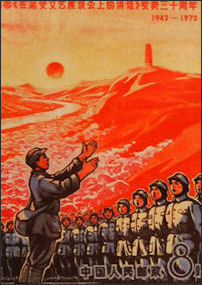
sing the revolutionary songs loudly The reform movement engendered by Deng Xiaoping had its origins in breaking through Mao’s cult of personality. Through the entire decade of the 1980s, veneration of CCP leaders was repressed. There were no grand lyrical tributes to Hu Yaobang and Zhao Ziyang, and songs were rarely sung in praise of Deng Xiaoping at the time. [Source: Xinhua News Agency report “Four Anthems Sing of a China Bravely Advancing,”Qian Gang, China Media Project, October 1, 2009]
As an anthem of political praise, “A Story of Spring” was a song very unlike “The East is Red”. Its lyricist, Jiang Kairu, was an old man who had lived a rough life. As a youth he had joined up with the People’s Liberation Army. But because he was found to have family in Hong Kong, and was therefore tied down by this alleged “overseas connection,” he was eventually forced out of the military and banished to the northeast, the “great northern wilderness” as it was called.
When the Cultural Revolution finally passed, Jiang felt as though spring had returned. In 1979, Jiang was permitted to come to Hong Kong to reunite with his family. He saw with his own eyes the changes reforms brought to Shenzhen in the years that followed.
In 1992, as Deng Xiaoping made his ‘southern Tour.” Jiang Kairu was moved by the wave of reports in China’s media urging further economic reforms. He was living in Shenzhen at the time, and toward the end of the year he composed “Spring Story”: “1979, a year of Spring An old man marks out A circle [of hope] in China’s south.”
These are lyrics penned by an ordinary man moved by Deng Xiaoping and the reform movement he represented. But the song gained in popularity only after 1996, as Deng Xiaoping fell gravely ill. It is perhaps impossible to know whether the paramount leader ever even heard “A Story of Spring” before he passed away in February 1997.
Into The New Age
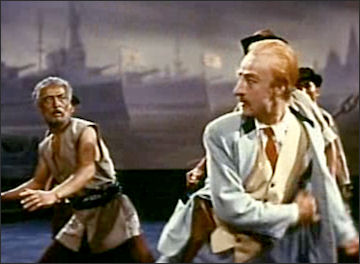
The East Is Red, the Film At the time Deng passed away, Jiang Kairu was working for the literary and arts federation of Lo Wu, on the Hong Kong-Shenzhen border. In anticipation of Hong Kong’s return to China that year, he wrote a song called “China is Blessed.”. The composer later recalled: “Leaders in Lo Wu excitedly glimpsed an opportunity: a song about three generations of party leaders.” [Source: Xinhua News Agency report “Four Anthems Sing of a China Bravely Advancing,”Qian Gang, China Media Project, October 1, 2009]
Local cadres worked together on the song lyrics, and the result quickly drew the attention of top leaders in Shenzhen. Once China Central Television got wind of the song, it was appropriated for a television spot. Ahead of the 15th National Party Congress in 1997, the song was reworked to become “Into the New Age,” layers of political propaganda thickening over it with each retouching. Even the folk rhythms of Jiang Zemin’s native northern Jiangsu province were incorporated.
By the time the fiftieth anniversary of the People’s Republic of China rolled around in 1999, the song had already become a propaganda anthem symbolic of Jiang Zemin’s leadership. The official People’s Daily praised the song, which it said ‘shaped the musical images of three generations of party leaders.” ““The East is Red,” we sing, Standing up on our own. We share a story of Spring, We prosper under reform and opening. He who leads us on the forward road, Takes us into a bright new age.”
“He who leads us on the forward road” was of course a reference to Jiang Zemin. During October 1 celebrations in 1999, “Into the New Age” was reserved for the climax of festivities. This was in fact the first clear instance of political hero worship since the onset of China’s economic reform policies, and it stepped way beyond the bounds that Deng Xiaoping had drawn.
Oh Lovely Land and On the Sunny Road
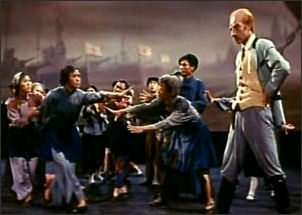
The East Is Red, the Film After becoming General Secretary of the CCP, Hu Jintao has invited caution in the assessments of him made by others. In Jiang’s day the media routinely used the phrase, “the central party the core of which is comrade Jiang Zemin.” When the torch passed to Hu Jintao, the language was a touch more cautious: “the central party of which comrade Hu Jintao is general secretary.” [Source: Xinhua News Agency report “Four Anthems Sing of a China Bravely Advancing,”Qian Gang, China Media Project, October 1, 2009]
The enthusiastic cheerleading for President Hu during the recent 60th anniversary celebrations was therefore all the more a surprise. Mao, Deng, Jiang and Hu were all represented together during the festivities. And in fact, the ceremonies included two anthems symbolic of Hu Jintao’s leadership.
“Oh, Lovely Land”, which accompanied the massive portrait of Hu, is perhaps not an anthem in praise of him personally, but praises him indirectly as a leader who “governs for the people” (“The ordinary people are the earth/ The ordinary people are the sky”).
“On the Sunny Road”, which Peng Liyuan sang over the grandiose fireworks display, was a clear and conscientious choice. ‘scientific development” and the “harmonious society” are political banners of Hu Jintao.
“On the sunny road, In the air the banners soar. Scientific development and harmony, Guide China to brighter shores.”
'Red Song' Campaign in 2011
Reporting from Chongqing, Barbara Demick wrote in the Los Angeles Times,” Although her musical tastes run to Mariah Carey and Norah Jones, Vicy Zhang didn't hesitate when she received an instant message inviting her to sing paeans to Mao Tse-tung at a celebration of the 90th anniversary of the Chinese Communist Party. "How could I refuse?" said Zhang, a 26-year-old graduate student at Chongqing University who hopes to join the party and have a career in civil service. "I thought it was boring and useless, but I didn't dare say no."[Source: Barbara Demick, Los Angeles Times, June 03, 2011]
More than 10,000 students and faculty members participated in the event last month. Although Zhang wore an evening gown, other students were dressed as Red Army soldiers, with red epaulets and armbands. Carrying red flags, they danced around a university athletic field with arms swinging rhythmically to martial music harking back to China circa 1966.
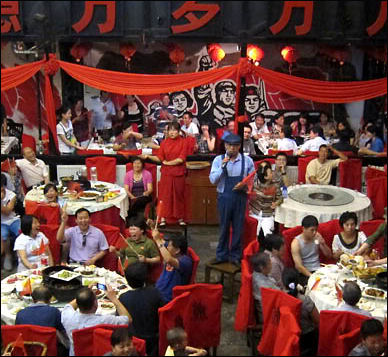
Cultural Revolution restaurant Throughout China, people are singing and dancing in homage to the Communist Party. The "red song" campaign began in Chongqing, where it was launched by party Secretary Bo Xilai, an ambitious politician who is believed to be angling for a seat on the Standing Committee of the Politburo."Red songs depict China's path in a simple, sincere and vivid way," Bo was quoted as saying by state news agencies in November. "There's no need to be artsy.... Only dilettantes prefer enigmatic works."
In conjunction with the 90th anniversary celebration in 2011 of the founding of the Communist Party of China was in Shanghai in 1921, the red song phenomenon has spread throughout the nation. In Beijing's subways, television screens show transit employees competing in a red song competition. In some parts of China, karaoke clubs have restricted playlists of Taiwanese love songs in favor of patriotic mainland ballads.
Under orders from the local propaganda department, Chongqing satellite television suspended its soap operas in favor of patriotic songfests. From April 20 to May 20, local newspapers had to publish the lyrics to familiarize the populace with the songs.Outside the airport, a billboard as high as a seven-story building features photographs of pink-cheeked young Chinese students and workers urging the public to "Sing Red Songs! Spread the Truth! Raise Your Spirits!" In public parks, retirees set up portable stereos and dance in long lines to songs praising Mao, even in Shapingba Park, which is next to an overgrown cemetery where thousands of people killed in the fighting of the late 1960s are buried.
Enthusiasm for the 'Red Song' Campaign
On Wednesday and Friday mornings at 7 a.m., former schoolteacher Cao Xingfen, 66, led fellow retirees through an elaborate dance routine set to red music, beneath billboards advertising Ermenegildo Zegna suits and Louis Vuitton bags. "These songs have a good rhythm; it's easy to dance to them," said Cao, a petite, silver-haired fireplug of a woman dressed in red pajamas. [Source: Barbara Demick, Los Angeles Times, June 03, 2011]
No doubt there is a genuine gusto for red songs, particularly among the older generation, for whom Communist marching songs are the campfire tunes of their childhood. On a balmy recent evening, a dozen people twirled through the dark in Renmin Park, the dancing figures illuminated by slivers of fluorescent light from a nearby beauty salon.
"We know these songs from our youth. We grew up with revolutionary spirit and we want to pass that on to our children," said Cai Derong, 55, who wiped his brow as he watched his wife, dressed for the occasion in a silky black-and-white dress, dance with one of her girlfriends. "Our economy is good. We want to express our appreciation to the Communist Party," piped in a middle-aged woman, Zhang Jin, who was also taking a break from the dancing.
Criticism, Lack of Enthusiasm and Mockery of the 'Red Song' Campaign
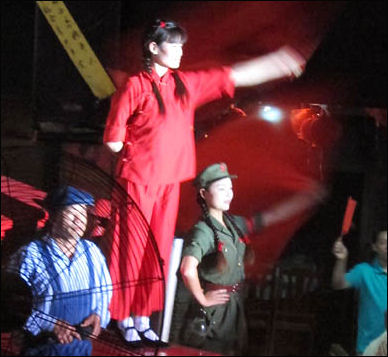
Cultural Revolution restaurant To critics, the Maoist revival has echoes of the maniacal quest for political correctness during the Cultural Revolution. "People with a sense of history look at it and wonder whether it is possible to go back to an era in which cruel things would happen again," said Alan Zhang, a recent law school graduate from Chongqing and blogger who, like other students interviewed, agreed to be quoted using only an English name. "The red song campaign has made Chongqing a laughingstock," he said.
"It's not that everyone is required to sing and love the songs. What we are seeking is a wider participation," Xu Chao, the Chongqing official in charge of the program, told the party-controlled Global Times.
At Chongqing's universities, those invited to participate in Communist Party anniversary celebrations were primarily party members and aspiring party members, many of them top students who see membership as a prerequisite to jobs in government or academia. "You have to accept when you get an invite, or you will be considered politically incorrect," said Owen Chen, a 24-year-old student and party member. "In our country, these are the kinds of things you have to do." [Source: Barbara Demick, Los Angeles Times, June 03, 2011]
When the invitations were sent out, students jokingly turned red song into a verb, saying to one another "I've been red songed. Have you been red songed?" Participation meant going to rehearsals up to twice a day in the weeks before the May 11 performance."I didn't see a single student who sang these songs with passion," Vicy Zhang said.
It wasn't just the inconvenience; the politics were distasteful to the students too. They said the performances looked just like the "loyalty dance" everybody was required to do during the Cultural Revolution, moving arms from the heart to the sun in a display of boundless devotion to Mao.
As soon as the music died, one of the older men sat down on a stone bench next to a reporter and in a loud voice offered up contrary opinion. "These people are all afraid to tell you the truth. They're dancing to these red songs because it is all they have in their brain. For 40 to 50 years, they've heard nothing else. The propaganda songs have drowned out regular Chinese folk music," said the man, Hu Jiaqing, 60. "It is just like the Cultural Revolution: They're using these big campaigns and movements to cover up their social problems.” None of the other dancers argued. They just drifted away in the dark.
Peng Liyuan, Revolutionary Singer and Xi Jinping’s Wife
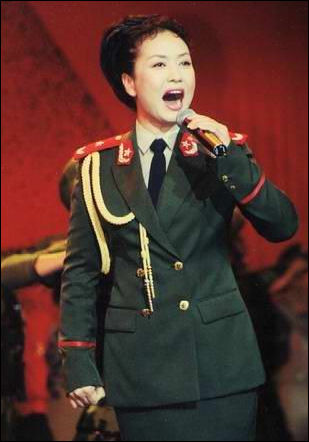
Xi Jinping’s wife, Peng Liyuan Peng Liyuan is the wife of Xi Jinping, the leader of China since 2012. She is a celebrated folk singer and for many years she was better known than him. Jane Perlez wrote in the New York Times: Peng Liyuan, China’s first lady, is glamorous, fashionable and one of her nation’s best-known singers, a startling contrast to her dour-looking predecessors.
“Ms. Peng became a household name in China well before her husband. She joined the People’s Liberation Army as a civilian when she was 18. She soon emerged as a talented singer with a voice suited to folk tales and operatic scores that heralded the bravery of China’s soldiers. For several decades, she starred in the nation’s annual New Year’s television extravaganza, where she wore boldly hued gowns with well-fitted bodices and flouncy skirts. [Source: Jane Perlez, New York Times, March 24, 2013]
Christina Larson wrote in Business Week, “In the mid-1980s, a baby-faced Peng burst onto the national stage as a touring vocalist with the People’s Liberation Army. “Early on, she was identified as a talented singer and given a role in the morale-boosting business,” says Andrew Scobell, an expert on China’s military at Rand Corp. “She performed in national song-and-dance tours—kind of like USO tours.” Her most famous song was “On the Fields of Hope,” which resonated with the optimistic spirit of the times. Peng’s appeal also transcended the military establishment. “We all knew she was an Army singer, because she was often wearing a uniform,” recalls the Chinese writer Xujun Eberleine. “But what I mainly remember was her voice—a soprano. It was very bright and upbeat.” [Source: Christina Larson, Business Week, June 4, 2013]
See Separate Article PENG LIYUAN: XI XINPING'S WIFE AND CHINA’S GLAMOROUS FIRST LADY factsanddetails.com
Image Sources: Mao-era poster (Landsberger Posters http://www.iisg.nl/~landsberger/) : ; Asia Obscura
Text Sources: New York Times, Washington Post, Los Angeles Times, Times of London, National Geographic, The New Yorker, Time, Newsweek, Reuters, AP, Lonely Planet Guides, Compton’s Encyclopedia and various books and other publications.
Last updated November 2021
